Scott Kenny
ACCESS: Above Top Secret
- Joined
- 15 May 2023
- Messages
- 5,995
- Reaction score
- 4,841
Were there any designs for a 3x3 18" turret version of the Montanas?
Bummer!No. Only a slow Iowa preliminary.
Early 18" shells were only 2900lbs, so the 16" 2700lb superheavy shells were better. Higher rate of fire and equal or better penetration.Yeah, the USN didn't seem to care for the 18" gun. They felt that the penalties of mounting it didn't outweigh its advantages. Especially in a treaty constrained design. IIRC, it had been considered for the Montana, but was ruled out on the grounds that 12x16" guns would outperform 9x18" guns for the roughly the same weight. (Going off memory because I'm at work, so that last part may not be 100% accurate)
PAVEWAY kit would not survive acceleration from gun launch.Now give it a rocket booster and PAVEWAY f
PAVEWAY kit would not survive acceleration from gun launch.
Imagine what Gerald Bull could do with a 3850 Ibs shell... he already had orbital plans out of 2700 Ibs...3800 pounds would have been a true Big Stick for diplomacy. Now give it a rocket booster and PAVEWAY for aircraft to designate targets at 100 miles away. Very expensive but able to pump out tremendous damage over a single ten minute interval.
How many US 18-inch guns were build ? Just being curious...
Ah. Didn't know that, thanks!PAVEWAY was once used as a general term for a lot of different guided munitions, including a laser-guided 8-inch naval gun shell.
Agreed, the control surfaces would be enormous. In fact, I suspect that maybe it would be more practical to use some kind of control engines on the 18-inch shell (like small solid-fuel ramjets, integrated into the base - advanced form of base bleeding).Edit: applying the same tech to something as heavy as an 18-inch shell seems a bit harder. The square-cube law is definitely not in your favor here -- bigger/heavier/faster shells will require disproportionately large control mechanisms.
PAVEWAY was once used as a general term for a lot of different guided munitions, including a laser-guided 8-inch naval gun shell.
Edit: applying the same tech to something as heavy as an 18-inch shell seems a bit harder. The square-cube law is definitely not in your favor here -- bigger/heavier/faster shells will require disproportionately large control mechanisms.
Agreed, the control surfaces would be enormous. In fact, I suspect that maybe it would be more practical to use some kind of control engines on the 18-inch shell (like small solid-fuel ramjets, integrated into the base - advanced form of base bleeding).
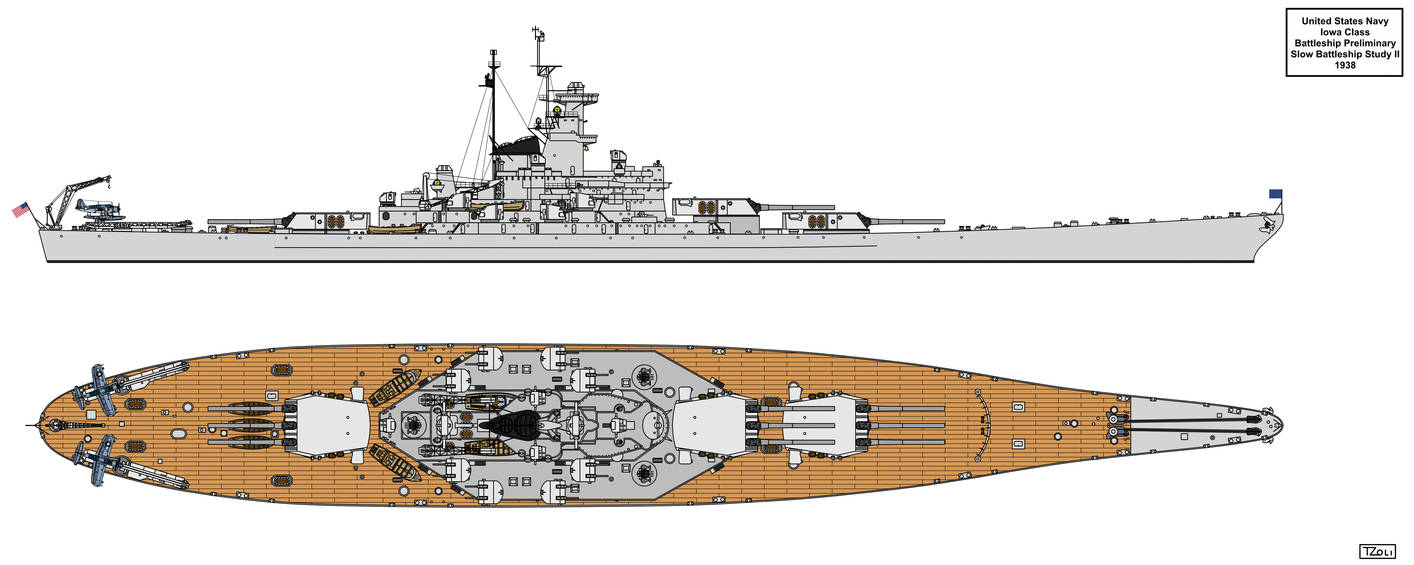
That depends on the option... the Colorado (Maryland, West Virginia, I've seen all 3 as the "class name") class 8 - 16" 4x2 battleships were simply a replacement of the Tennessee class' triple 14" turrets with twin 16" ones... in a barbette 6" smaller in inside diameter, something that would be easy to adjust just before installing the loading equipment and turret mechanisms.Montana had a pretty broad beam already, you'd have to rearrange the internal layout for sure but I think you could accommodate 3 triple 18"/48 caliber turrets within those dimensions.
It probably depends on how much redesign the USN would want to do which would depend on other factors like when there would be the space available in the shipyards to start construction.
I think the three shipyards which would be building the Montanas could only fit one at a time each so if the first three 16" gunned members of the class were being built as planned that leaves quite a bit of time before work could start on the remaining two or some 18" gunned variation of the class.
I'm guessing 3" thicker barbette armor?That depends on the option... the Colorado (Maryland, West Virginia, I've seen all 3 as the "class name") class 8 - 16" 4x2 battleships were simply a replacement of the Tennessee class' triple 14" turrets with twin 16" ones... in a barbette 6" smaller in inside diameter, something that would be easy to adjust just before installing the loading equipment and turret mechanisms.
The shipbucket drawings does not fully gives back the true look of the BB67-4 Montana:
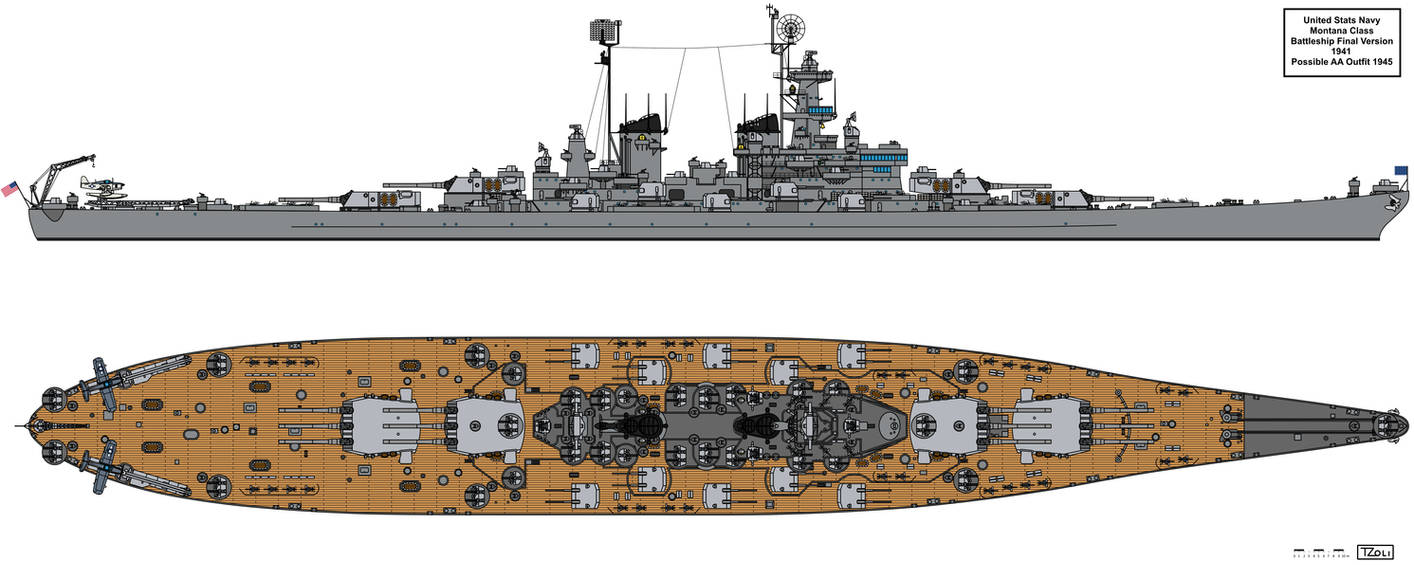
Montana class Battleship Final Design by Tzoli on DeviantArt
www.deviantart.com

I tend to agree with your overall idea, but for slightly different reasons. Going with four 18" twin turrets would not require a major redesign of everything else. Going with three triples would. Such a major redesign would not be impossible, but it would be a significant effort.The only practical way to get 18" guns on the Montana design would be to replace the 4 triple 16" turrets with twin 18" ones... triple 18" turrets would require a too large diameter turret (and more powerful/bulkier machinery etc to turn them), which would mean an even broader beam, with the resulting reduction in speed.
Thus, an 18" Montana would almost certainly have 8 - 18" (4 x 2) guns.
The person who gave me advices is an expert in the USN especially the Iowa and Montana classes so I draw it according to him. I will have to check the sketch I've used as a basis though.No disrespect but the bridge arrangement is not correct. The Montanas reverted to the separate pilot house/ACT arrangement; very similar to the North Carolina class (from the contract plans.) The integrated ACT pilot house was generally disliked by the USN but forced by the necessity of treaty compliance. The Montanas had no such restrictions, hence the reversion to the separate arrangement.
Bill Jurens (and Chris Wright) are among the most knowledgeable of the WW2 era USN, especially when it comes to technical history. I've known Bill for over 25 years (he and I coauthored a article in Warship International in 2005) and his personal archive is extensive. He has duplicates of the official Contract Plans so I asked him a few years ago to clarify this very question a for me.The person who gave me advices is an expert in the USN especially the Iowa and Montana classes so I draw it according to him. I will have to check the sketch I've used as a basis though.
Note: most Montana related material got destroyed in tge 1970' when reorganizations were made regarding the papers of old designs and someone thought thesd were not necessary to exist anymore...
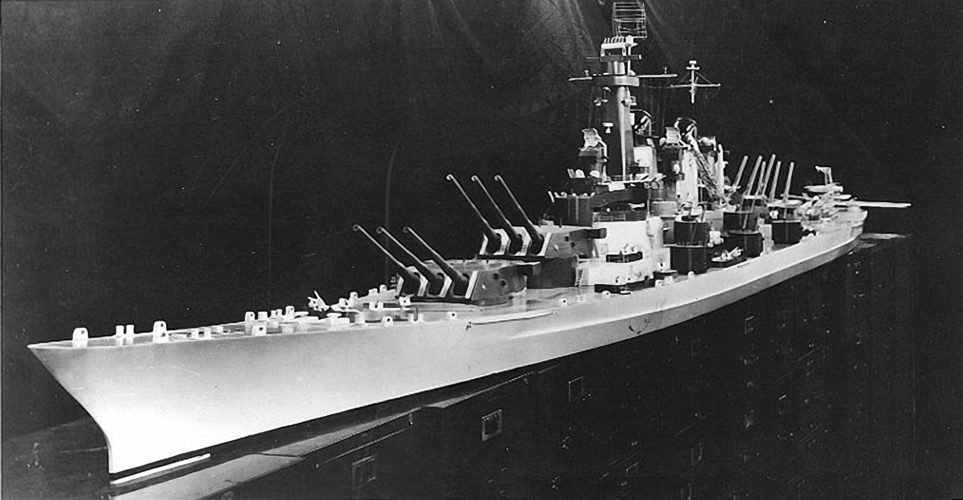
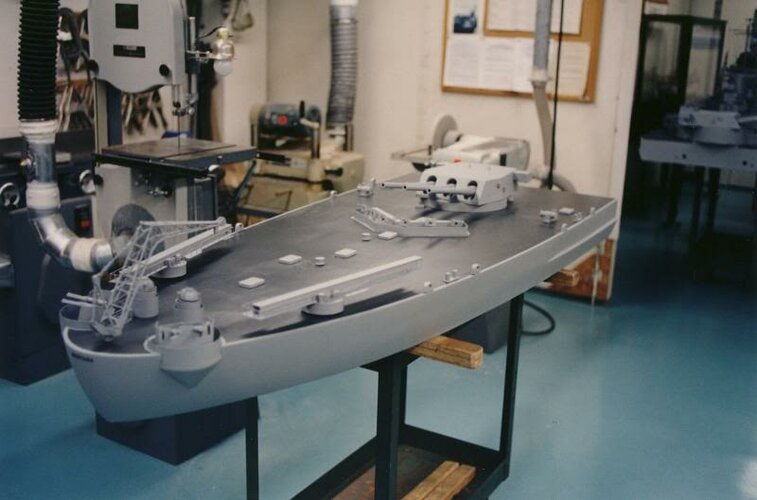
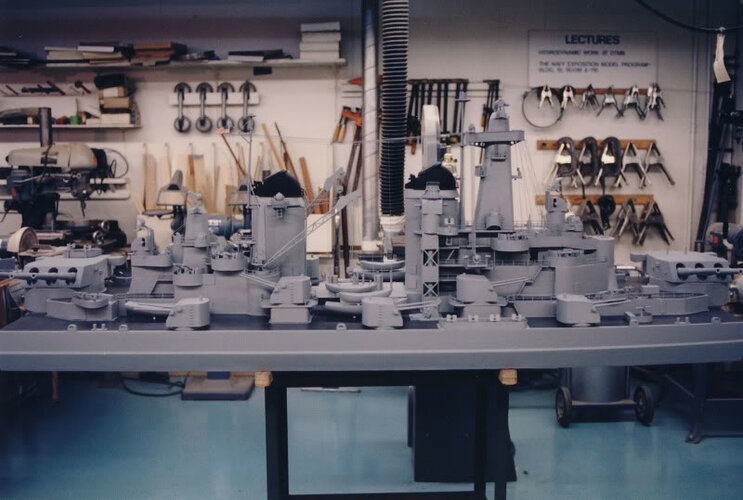
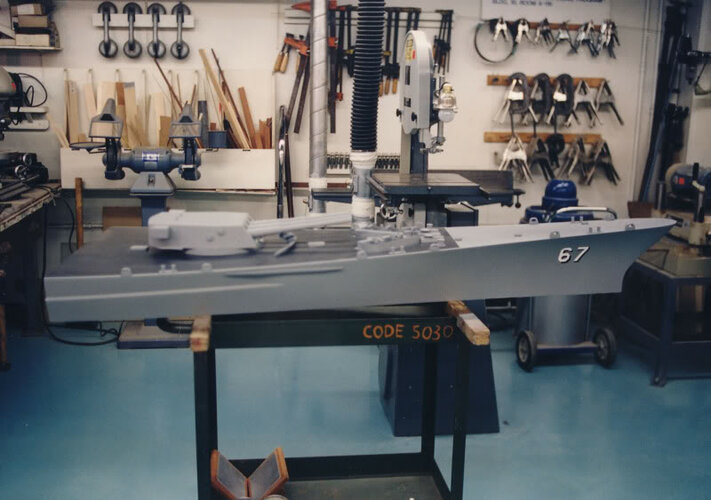
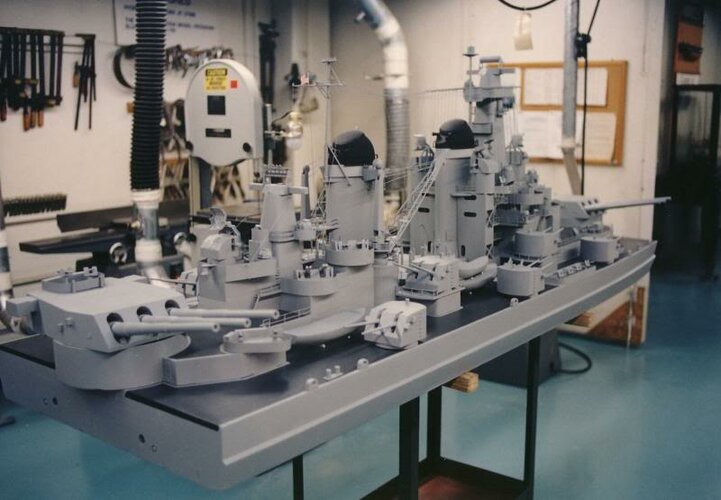
Interesting that this repainted model retailed the 40 mm quad mounts rather than the 3"/50 dual mounts that would have replaced them. The shape of the 5"/54 turrets also resemble the older 5"/38 Mk 28 mounts rather than the Mk 41 that the Montanas would have gotten.Interestingly, this model was later painted in post war gull grey and I found images of it online. You can see below a bit better image of the bridge in these images. The pilot house is just below and forward of the forward Mk37 secondary battery director:
It is difficult to tell because of the low resolution, but the B&W image of the contract model had the current radar and 40mm/20mm AA battery configuration that were fleet standard for most of the war. Just my WAG but I guess that it was simply repainted, possibly to preserve or refurbish, the model as it appears to me that the model was not changed in any of the details.Interesting that this repainted model retailed the 40 mm quad mounts rather than the 3"/50 dual mounts that would have replaced them. The shape of the 5"/54 turrets also resemble the older 5"/38 Mk 28 mounts rather than the Mk 41 that the Montanas would have gotten.
As a side note, I believe the contractual design of the Iowas also had a gap between the front funnel and the fire control tower that was eventually closed when the ships were built, with the volume used for electronics. I wonder if the same would have happened to the Montanas had they been built.
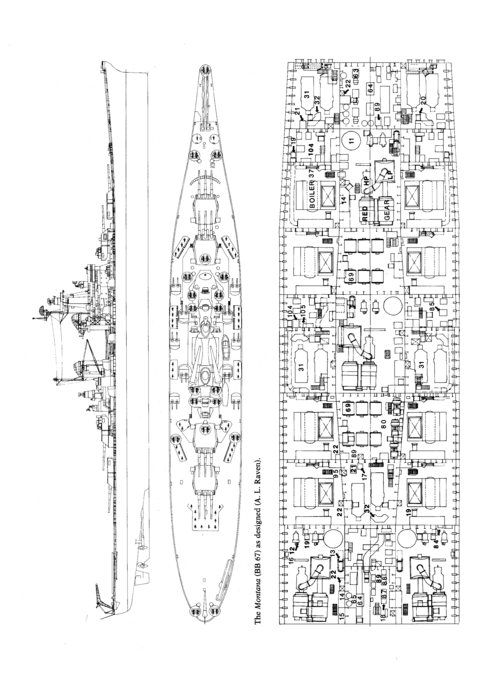

I do know that the Original design for one of the middle Standard Battleship classes, either the New Mexico or Tennessee, was ORIGINALLY slated for twin 16inch turrets like on the Colorados. But was change at the last moment by the Secnav at the tine for some reason that escape at them moment.That depends on the option... the Colorado (Maryland, West Virginia, I've seen all 3 as the "class name") class 8 - 16" 4x2 battleships were simply a replacement of the Tennessee class' triple 14" turrets with twin 16" ones... in a barbette 6" smaller in inside diameter, something that would be easy to adjust just before installing the loading equipment and turret mechanisms.
Yeah, so this? This is 100% because Josephus Daniels, Wilson's SECNAV, was a complete and total moron who didn't have a clue what he was doing. As far as I can find, the only reason he was appointed to his position was because he agreed with Wilson on his racial views. Namely that he was virulent white supremacist and raging racist. He was easily one of the top 5 worst Secretaries of the Navy we've ever had.I do know that the Original design for one of the middle Standard Battleship classes, either the New Mexico or Tennessee, was ORIGINALLY slated for twin 16inch turrets like on the Colorados. But was change at the last moment by the Secnav at the tine for some reason that escape at them moment.
I had read that the Navy wanted 16" for the Pennsylvanias, but Daniels overruled them on the fear that the still in development 16"/45 wouldn't be ready by the time the ships were. To me, that would have at least been a reasonable "no." Delays in weapons programs aren't exactly a new thing after all. And again, from what I had read, the Navy didn't fight for it too hard, figuring that the follow on New Mexicos would certainly get them. But Daniels still refused to allow the a Navy to go to 16". I could be wrong on it, but that's what I had read about them.The first ships to consider 16" guns were the New Mexicos; an eight-gun battery was considered for the Pennsylvanias, but it was for a notional 15" gun.
I think the number of main guns installed on the Montana-class battleships depends on the USN's intelligence on Japan's new battleships.If the U.S. Navy had known between 1938 and 1940 that the main gun of the Yamato class was 18.1 inches, then it is certain that the design of the Montana class would have been around an 18-inch or larger caliber, never 16 inches. I think 9-18"(3x3) is the most reasonable scheme.The only practical way to get 18" guns on the Montana design would be to replace the 4 triple 16" turrets with twin 18" ones... triple 18" turrets would require a too large diameter turret (and more powerful/bulkier machinery etc to turn them), which would mean an even broader beam, with the resulting reduction in speed.
Thus, an 18" Montana would almost certainly have 8 - 18" (4 x 2) guns.
I'm not so sure. USN and many other navies generally came to conclusion that guns heavier than 16-inch are more problematic than advantageous.I think the number of main guns installed on the Montana-class battleships depends on the USN's intelligence on Japan's new battleships.If the U.S. Navy had known between 1938 and 1940 that the main gun of the Yamato class was 18.1 inches, then it is certain that the design of the Montana class would have been around an 18-inch or larger caliber, never 16 inches. I think 9-18"(3x3) is the most reasonable scheme.
When using Super heavy shells, the 16"/50 gave armor penetration equal to the 18" gun. But it delivered it at a higher rate of fire, and with fewer reliability issues. As is with 16" guns, the Montana class would have delivered a heavier broadside than the Yamato class did. And delivered it more often. I think the Navy sticks with the 16"I think the number of main guns installed on the Montana-class battleships depends on the USN's intelligence on Japan's new battleships.If the U.S. Navy had known between 1938 and 1940 that the main gun of the Yamato class was 18.1 inches, then it is certain that the design of the Montana class would have been around an 18-inch or larger caliber, never 16 inches. I think 9-18"(3x3) is the most reasonable scheme.
